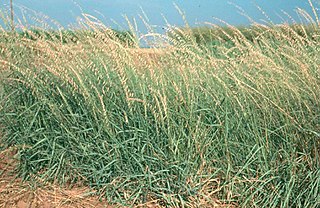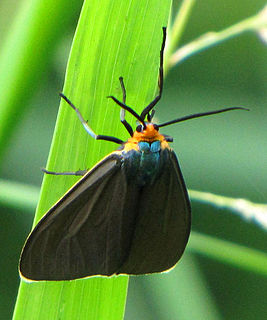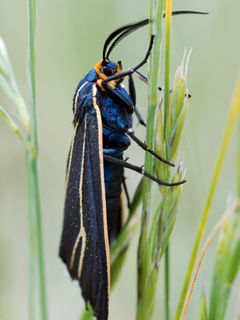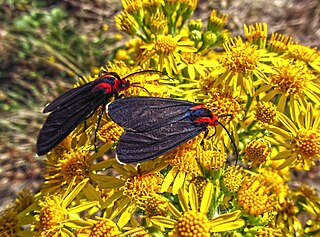
Bouteloua curtipendula, commonly known as sideoats grama, is a perennial, short prairie grass that is native throughout the temperate and tropical Western Hemisphere, from Canada south to Argentina.

Hypena is a genus of moths in the family Erebidae. It was first described by Franz von Paula Schrank in 1802. These non-migratory moths overwinter as pupae and almost never come to bait as adults.

Agylla is a genus of moths in the subfamily Arctiinae. The genus was erected by Francis Walker in 1854.

Ctenucha is a genus of moths in the family Erebidae.

Cisseps fulvicollis, the yellow-collared scape moth, is a species of the family Erebidae and subfamily Arctiinae. It was described by Jacob Hübner in 1818.

Ctenucha virginica, the Virginia ctenucha, is a moth of the family Erebidae. The species was first described by Eugenius Johann Christoph Esper in 1794.

Ctenucha cressonana, or Cresson's ctenucha, is a moth of the family Erebidae. The species was first described by Augustus Radcliffe Grote in 1863. It is found in the US Rocky Mountains, including Colorado and New Mexico.

Ctenucha brunnea, the brown ctenucha or brown-winged ctenucha, is a moth of the family Erebidae. The species was first described by Richard Harper Stretch in 1872. It is found in the US from central to southern coastal California.
Chalcosia is a genus of moths in the family Zygaenidae.
Ctenucha quadricolor is a moth of the family Erebidae. It was described by Francis Walker in 1866. It is found on Jamaica.
Ctenucha devisum is a moth of the family Erebidae. It was described by Francis Walker in 1856. It is found in São Paulo in Brazil and in Argentina.
Ctenucha editha is a moth of the family Erebidae. It was described by Francis Walker in 1856. It is found on Haiti.

Ctenucha multifaria is a moth of the family Erebidae. It was described by Francis Walker in 1854. It is found in the US states of California and western Oregon.
Ctenucha rubriceps is a moth of the family Erebidae. It was described by Francis Walker in 1854. It is found in Mexico, Guatemala, Costa Rica, Colombia, Venezuela, Brazil and Uruguay.

Ctenucha rubroscapus, the red-shouldered ctenucha moth, is a moth of the family Erebidae. It was described by Édouard Ménétries in 1857. It is found in western North America, where it is limited to low elevations west of the Cascade Mountains, south of Chehalis in Washington. The habitat consists of coastal grasslands adjacent to the ocean, as well as wet boggy meadows and wet prairie.
Ctenucha ruficeps is a moth of the family Erebidae. It was described by Francis Walker in 1854. It is found in Mexico.
Ctenucha semistria is a moth of the family Erebidae. It was described by Francis Walker in 1854. It is found in Brazil.
Venosa may also refer to:
Chalcosia venosa is a moth in the family Zygaenidae. It was described by Francis Walker in 1854 from Sri Lanka.
Scopelodes venosa is a moth of the family Limacodidae first described by Francis Walker in 1855. It is found in Sri Lanka, China, India, northern Myanmar, northern Thailand, northern Laos, Vietnam and Nepal.









